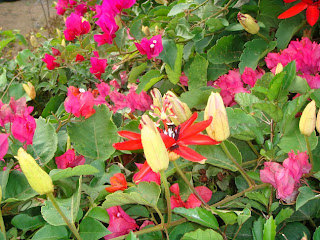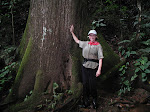 |
| Gurania makoyana |
Take a look at the fascinating bloom of Gurania makoyana (f. Cucurbitaceae). Barry – is that the right name? This plant grows well down at the edge of the forest at Tigre hill and the bloom lasts for weeks. Lots of wild flowers and vines are in bloom at the moment – Ageratums, Iresines, Lobelias and species in the mint, daisy, verbena and Morning Glory families by the score!
Here’s a picture I took today down in the lower pasture of Tabebuia rosea (Roble de la Sabana). You can see the pink and yellow blooms of Tabebuia species all over the Central Valley right now. They are deciduous - dropping all their leaves prior to flowering - so the canopy becomes a totally eye-popping show. The Cortez Amarillo (Tabebuia ochracea) is also in full bloom right now in the coffee fields nearby but, here at El Tigre, the tree has still not dropped the leaves, so we don’t expect flowering until later in the month.
Another yellow bloom in the Trumpet Vine family sparkling up the roadsides is Tecoma stans (Vainillo) a small tree that tolerates extreme drought and rocky inclines; dozens of Vainillo trees perch jauntily all over the cliff-sides along the highway between Ciudad Colon and San Jose. Note the leaves and flowers together. Willow Zuchowsky writes in “A Guide to Tropical Plants in Costa Rica”, that Tecoma stans can easily be reproduced by cuttings, and that is very true! Other roadside trees in bloom: Poro (orange flowers) and Jacaranda (violet flowers).
Nancy, look at the color popping over the Hibiscus shrubbery! Assorted Bougainvillea cultivars (shades of bright pinks) co-mingling with blue Petrea, purple Morning Glories, yellow Allamanda and, for the reddest red (la mas roja - zui duo hong se de) of any flower I have ever seen, Passiflora vitifolia! Such a blast of intense color might assault the sensibilities of, say, those English gardeners who might gasp in shock at a multi-colored Azalea shrubbery in full, kaleidoscopic bloom. It’s all just too bright – too much for the eye!
Or is it? We are having solar flares today – the sun feels too intense to go outside. Thus, I’m typing this while gazing out the window at the transformation of the shrubbery just below. From the smooth, clipped-hedge green, shaped charmingly by Armando these past 5 years, we now see encroaching eye-popping magenta and pink bracts, mixing with red and blue flowering vines crawling here and there. Will Armando manage to tame the tangled monster into something pleasing to the eye without losing the view? Easy Peasey! And, yes, it goes without saying that we have added edible vines to the tangle – chayote and granadillas.
Here’s a shot of Danny helping his dad out in the garden. Danny just turned 10 years old and, typical of that age, he’s curious about absolutely everything – gardening, animals, electronics. If it exists, he’s interested in it! Experiments abound all over the place! Learning comes from failure as well as success; perhaps the best lessons come out of something that didn’t work as expected - understanding why.
Here’s Danny again, helping process the frijol harvested a few weeks back. The guys harvested an awesome crop of beans this year and we feasted on frijol molido for Danny’s birthday! We just began an experiment using spring water to feed a garden in a clearing in the secondary forest, to see what thrives and what doesn’t. However, the dogs wrecked our first attempt, and so we are now fencing in a second attempt…
Poor Flopsy has suffered these past weeks with yet another bout of ‘kennel cough’; it always seems to affect him but not the others. However, as it wouldn’t get better, Yaneth took him to the vet today and came home with meds, including prednisone - poor little Flopsy. Our old dog, Tigre, was in the middle of a course of antibiotics when he went missing, never to be seen again!
Zinc is still a pup, as the destroyed rugs and shoes lying all around constantly remind us. Training puppies teaches all of us patience; a good lesson for kids to learn (and GRAK…). And we’re always learning new things here. I was tempted the other day to get into apiculture (bee-keeping) until Armando - well experienced in the art - told me the story about someone in Puriscal who wanted to get rid of all of it – sell it all cheap – name your price – because the Africanized bees killed his horse and some chickens! We currently benefit from the bee hives located just below on a neighbor’s forested property. There are no animals or people living near the hives and the bees travel up the mountain for the pollen in our gardens and orchards here. We enjoy the honey; they enjoy our pollen – a mutually beneficial situation…
Take a look at Gerry with the most perfect lemon (for his G & T, of course!) Armando has brought home to us yet. If we can’t grow something here, then we buy it from the neighbors. We always buy locally if we can; it keeps the economy rolling along and keeps our own garden experiments to a manageable number. Focus is essential for success. This is a lesson I never seem to learn, however! Hugo just walked over with a bag of coffee, grown at a local farm and roasted in San Jose. Wonderful local coffee! But no, we shall not grow coffee here…
Next time you drive by a rubbish heap, stop your car and take a careful look at it. You might find a treasure there, thus reducing the pile. Last Sunday, University of Peace students and El Rodeo neighbors did an awesome job hauling a lot of ‘stuff’ out of the river - old chairs, tires, broken toys, all manner of debris - and it is now all piled up along the side of the road awaiting collection by the Municipality. But, yikes, the Municipal Truck is broken! However, let’s not complain; let’s take the opportunity to go over there and rubbish hunt. It’s a kind of in-your-face lesson on the Law of Unintended Consequences... Luckily, villagers now have many more recycling options, rather than just hurling stuff out into the creek. I am really very proud and grateful to the UPaz students for taking on this project, along with neighbors of El Rodeo.













